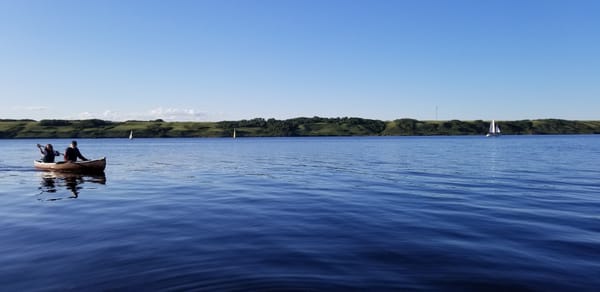Here's a fun fact that's about to ruin your day: if you own waterfront property in Saskatchewan, that beach you've been maintaining, protecting, maybe even shooing trespassers off of? It's not yours.
The Water Security Agency is pretty blunt about this:
"Most lake/river front property owners in Saskatchewan do NOT own the land right to the water's edge."
They actually put "NOT" in all caps, just so there's no confusion.
Before you start arguing about what your real estate agent promised or what the neighbour told you when you bought the place, here's how it actually works.
The Cold, Hard Truth
Waterfront land ownership in Saskatchewan is actually much simpler than in most other provinces - just not in the way you might want to hear.
That strip of sand, rocks or aquatic plants between your cabin and the water? It's called "dedicated lands," and it belongs to the Crown. As in, the government owns it, manages it, and decides what can and can't happen on it. In some areas, dedicated lands extend even further upland.

At most, your property ends at what's legally called the "bank", defined as "the ground bordering the water that acts to contain the water in the body of water."
The Water Security Agency gets even more specific: you can identify the bank by where the vegetation changes from aquatic to riparian species. In other words, where the water plants stop and the land plants start? That's your property line, friend.
But My Deed Says Waterfront!
I know what you're thinking. You paid waterfront prices. The listing said waterfront. Hell, you might have even been maintaining that beach for twenty years. Doesn't matter.
Here's what the Water Security Agency wants you to know (and they actually put this in their official documents):
"This may differ from what you assume you own, or what you have been told by your real-estate agent or neighbours."

The only thing that matters is your land title and the survey plan. And chances are that if you dig those out right now, they don't actually extend to the water.
With that said, there are exceptions.
In some cases, the legal boundaries of a private lot may extend to the bank or into the boundary area. Dedicated lands are defined by title and legal survey and do not necessarily align with the bed, bank or boundary of a waterbody.
What This Actually Means
So what can and can't you do? Let's break it down:
You CAN'T:
- Build anything on the beach without municipal permission
- Put up a fence to the water
- Tell people to get off "your" beach
- Dump sand to make a bigger beach
- Install permanent furniture or structures
You CAN:
- Access the water (you still have riparian rights)
- Apply for permits to do approved work
- Use the beach like everyone else
- Maintain a path to the water (with permission)
The kicker? Any alteration to those dedicated lands requires permission from your local municipality. And any alteration within the bed, bank, or boundary of the water itself? That needs a permit from the Water Security Agency.
The Dock Dilemma
"But what about my dock?" you're asking. Good question. And the answer might make you even more uncomfortable than the beach ownership issue.
If your dock is sitting on dedicated lands or extending into the water without proper permits, you're not just technically trespassing on Crown land - you're also opening yourself up to theoretical liability issues.
Here's what the Water Security Agency wants you to know: any structure placed on public land without authority could be assumed by the public as an invitation for use. That's right - that private dock you built? The public might legally be able to use it.

The WSA puts it bluntly:
"Although your dock/structure is a private structure, it would be difficult for you as the owner of the dock, to initiate a civil action against someone else for using it."
But wait, it gets worse. They add this warning in their official documentation:
"The owner(s) of unapproved structures are liable for them and their use by others. (If someone gets injured, you could be liable)."
So not only can't you stop people from using your unpermitted dock, but if some stranger slips and breaks their ankle on it? That lawsuit is coming your way.
The solution? Get your permits and check with the RM to make sure you've got yours i's dotted and t's crossed.
The Environmental Angle
Here's the thing Saskatchewan officials want you to understand: this isn't just bureaucratic nonsense. Those shoreline areas are critical for lake health.
When property owners modify beaches, build too close to the water, or mess with the natural vegetation, it affects water quality, fish habitat, and erosion patterns. One cottage owner fertilizing their lawn down to the "beach"? Not a big deal. Two hundred doing it? That's how you get algae blooms that can kill a lake.
The Water Security Agency is pretty blunt about this
"What goes on your lawn also goes into the lake."
So What Now?
Look, I get it. This isn't what you wanted to hear. You bought waterfront property expecting to own waterfront. But here's my advice:
First, check your title and survey. Know exactly where your property ends. If you don't have a recent survey, get one. It'll save you grief later.
Second, before you do ANY work near the water - and I mean anything more than setting up a lawn chair - check with your municipality and the Water Security Agency. The permits might be a pain, but they're nothing compared to the fines and removal orders.
Third, embrace the reality. You still have access to the water. You can still enjoy the beach. You just share it with everyone else who has access to Crown land. And honestly? That's kind of the Canadian way, isn't it?
The Silver Lining
Unlike some provinces where shoreline ownership is a complex mess of historical grants and shifting boundaries, Saskatchewan keeps it simple: you don't own it. End of story.

Next time you're at the lake, take a closer look at where the vegetation changes. That's your real property line. Everything beyond that?
It's a shared resource, protected for everyone.






Join the Conversation